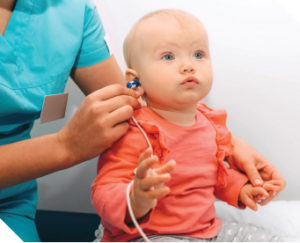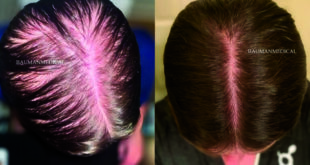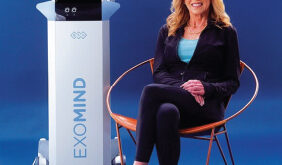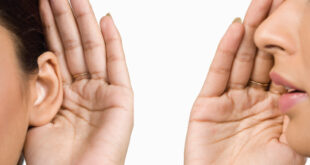 When you think about eyeglasses, what do you think of? Most likely your own pair or those of loved ones. If you’re more fashion-minded, you might even think about that funky pair you saw recently on one of your favorite celebrities. You definitely don’t think of old age.
When you think about eyeglasses, what do you think of? Most likely your own pair or those of loved ones. If you’re more fashion-minded, you might even think about that funky pair you saw recently on one of your favorite celebrities. You definitely don’t think of old age.
But what about when you think of hearing aids? Probably a different story.
A PR Problem
In the United States, 14 million people 12 years or older have a visual impairment. Thirty million people 12 years or older have hearing loss in both ears — that’s one out of every eight people.
Both eyeglasses and hearing aids correct a sense impairment — so why are eyeglasses a fashion statement, but it takes, on average, seven years for someone to even get their hearing tested after noticing a hearing loss?
Hearing Loss Affects All Age Groups
The idea that hearing loss is something that happens to people in their old age simply isn’t true. Significant numbers of people across all generations experience some degree of hearing loss.
Children
2 to 3 of every 1,000 U.S. babies are born with a detectable hearing loss
1 in 5 U.S. teens has some degree of hearing loss
1 in 8 U.S. kids ages 6 to 19 has hearing loss from using earbuds to listen to music at unsafe volumes
Over 90 percent of U.S. children born with hearing loss have parents with no hearing loss.
Young adults
According to a World Health Organization report, 50 percent of millennials risk hearing loss because of damaging volumes via personal audio devices; 40 percent do so via noisy entertainment venues such as concerts.
Adults
About 1 in 7 U.S. adults ages 20 to 69 has hearing loss.
22 percent of U.S. adults are exposed to dangerous noise levels at work.
About 1 in 10 U.S. adults experiences tinnitus (a ringing, pulsing, or buzzing only they can hear).
About 90 percent of tinnitus cases have accompanying hearing loss.
Service members
3 in 5 returning service members experience hearing loss.
Among both active and veteran service members, hearing loss and tinnitus are the most reported health issue.
50 percent of all blast-induced injuries result in permanent hearing loss
Hearing loss among service members has become a big enough problem that the Department of Defense spearheaded an interactive course that provides early and ongoing hearing loss-prevention training
Normalizing Hearing Loss
Clearly, hearing loss is even more prevalent than vision problems. And it leaves no age group untouched. But the stigma remains, such that only 1 in 5 people who could benefit from hearing technology actually uses it.
But there’s a growing online trend of people discussing their lives with hearing loss — many of them millennials or slightly older — in an attempt to remove the stigma of hearing loss and hearing aids.
Living With Hearing Loss is written by Shari Eberts, who was recognized as a HearStrong Champion for her tireless work to change the stigma surrounding hearing loss.
The Invisible Disability and Me is written by a woman with a cochlear implant who hopes to raise awareness of and support those who’ve experienced sudden sensorineural hearing loss.
Cosmopolitan magazine’s brand connection to millennial women is so strong that it launched a Cosmo Millennial Advisory Board staffed with millennials who are experts in their fields; Cosmopolitan regularly features articles about life with hearing loss, covering topics from dating with hearing loss to becoming a NASA engineer despite having been born profoundly deaf.
The Twitter page Normalize Hearing Loss is “on a mission to normalize hearing loss and hearing aids and other tech the way we’ve normalized glasses,” and encourages users to include @NormalizeHL or #NormalizeHearingLoss in their tweets.
Hearing Tech for
Today’s Connected Culture
What’s more, the hearing technology of today is a far cry from the hearing aids of 50 years ago. The digital tech of today is sleek and discreet, minimizes background noise, improves speech clarity in complicated sound environments, and focuses on what’s in front of you rather than taking in and amplifying all sounds equally.
Plus, hearing devices are becoming as connected as everything else. You can stream audio wirelessly from your mobile device to your hearing aids, geotag the hearing aid settings for your favorite locations, even hear a phone call in both ears simultaneously — and control it all on the sly with a smartphone app!\
Originally from Southern NJ, Dana Luzon received her undergraduate degree in Speech Pathology and Audiology from the Richard Stockton College of NJ, and continued on to receive her Doctorate of Audiology at Salus University’s residential program. Her varied clinical experiences throughout her doctoral studies include: VA hospitals, rehabilitation clinics, ENT and private practice settings. Her professional inte-rests include: audiologic rehabilitation and progressive tinnitus devices. Her interests in the field outside of the clinic include: Humanitarian Audiology, and Audiology Awareness. Dr. Luzon currently lives in West Palm Beach, FL.
Audio0logy and Hearing Aids of the Palm Beaches
561-536-5557
4266 Northlake Blvd.,
Palm Beach Gardens, FL 33410
HearingCareFL.com
Check Also
Physical Therapy for the Brain
Have you noticed you have difficulty hearing your family and friends in a noisy restaurant? …
 South Florida Health and Wellness Magazine Health and Wellness Articles
South Florida Health and Wellness Magazine Health and Wellness Articles




